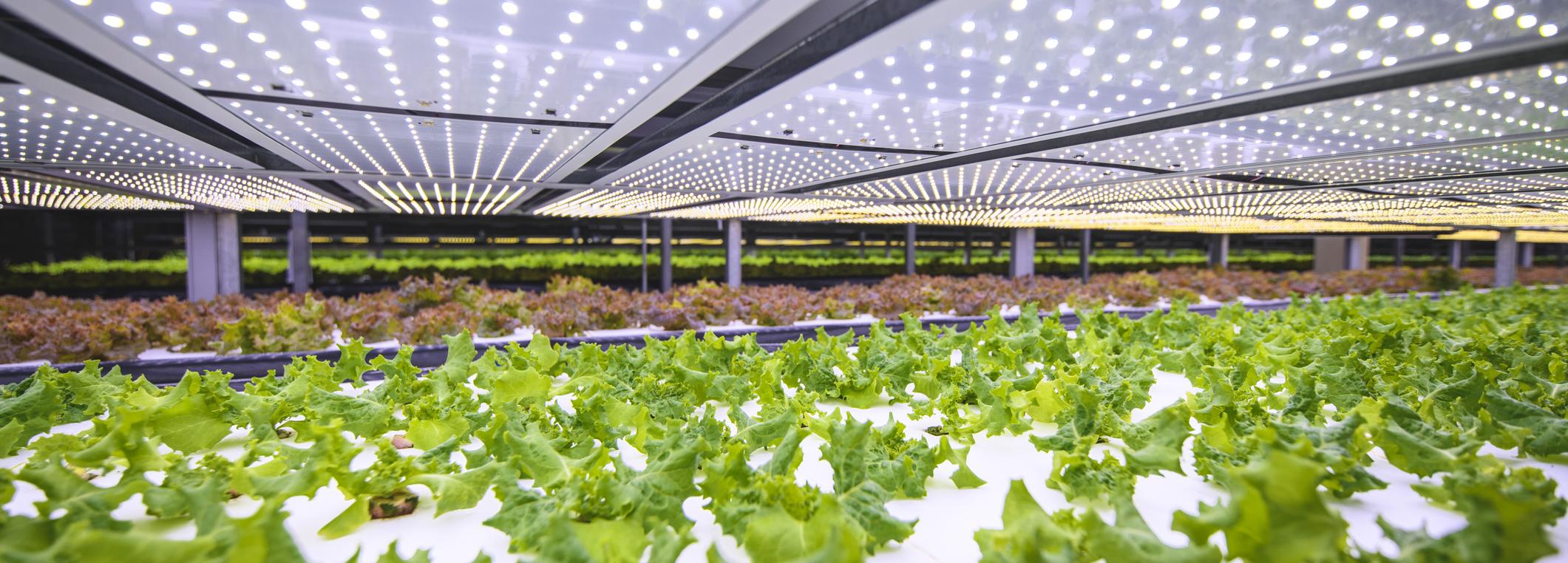
North America’s Role in Future Proofing Tomorrow’s Food Supply
-
bookmark
-
print
With the global population forecast to grow to more than nine billion by 2050, it came as little surprise that food security was a key theme at the Biodiversity COP15 in Montreal and had a full day dedicated to it at the COP27 Climate Conference in Egypt last month.
The Adaptation and Agriculture Day at COP27 saw the introduction of the Initiative on Climate Action and Nutrition (I-CAN), which seeks to accelerate the role of national climate policies in shifting our entire food systems to achieve net-zero emissions and improved health outcomes.
It also saw the introduction of the Food and Agriculture Sustainable Transformation (FAST) Initiative, launched by the COP27 Presidency and UN Food and Agriculture Organization, which aims to scale climate finance flows to transform food and agriculture systems.
Be it the war in Ukraine, some of the worst droughts in recent memory and numerous other global extreme weather events, or rising protests from farmers who say climate policy will strangle their ability to produce affordable food, 2022 underscored the challenges of feeding a growing world population while reducing greenhouse gas (GHG) emissions.
Those challenges mean the countries that will lead global food production tomorrow will need to find ways to produce more food while reducing emissions and keeping their farmers in business.
Canadian and U.S. governments are broadly opting for strategies that help farmers shift toward sustainable agriculture rather than mandating GHG reductions and putting the costs onto producers. Instead of specific emission reduction targets, policy makers have signalled billions in expanded support—through the Inflation Reduction Act and Emission Reduction Plan, in the United States and Canada respectively—to advance farmers’ continued effort to reduce emissions. On top of existing grants and incentives, governments are committing incremental funds to scale adoption of precision agriculture and low- or zero-emission farming technologies, to deploy on-farm renewable energy production, to grow an R&D system that will provide the next generation of low carbon solutions, and to increase the ability of farmlands to store carbon.
Against this backdrop, to meet the increasing expectation for continued abatement in the sector, governments are also testing the waters with targets to reduce emission from key sources. Canada, for example, recently completed consultation on a proposed voluntary target to reduce nitrogen emissions from fertilizer by 30% below 2020 levels.
Stable Emissions
Emissions from the agriculture sector have remained stable in both Canada and the United States as efficiencies have balanced increased output, but as global food demand grows, governments in both counties are expecting emissions in the agriculture sector to increase. Methane and nitrogen use, which are the largest contributors to the sector’s GHG emissions, are anticipated to climb to 625 Mt CO₂ eq by 2030, for example.
Reducing these emissions will not be cheap. According to McKinsey & Company, reaching net-zero goals by 2050 will require some USD$840 billion in annual investment. It will also depend on farmers’ ability to realize the potential of soil carbon sequestration so that they can monetize emission reductions.
Approximately ~1,500 Mt CO2 eq is stored in the top 30cm of agriculture soils in Canada and the US—equivalent to more than 2x the annual emissions from both countries’ agriculture sectors. This pool of stored carbon represents a significant removal of GHGs from the atmosphere, and there is further potential to be unlocked from the sector’s agriculture soils.
Monetizing this potential will require a strong demand pull from voluntary carbon markets that have yet to mature. Key enablers to these market conditions include a rising price on carbon, policy certainty through industry-specific offset protocols, and expertise from companies that support farmers in GHG calculations and carbon credit generation and monitoring.
Advancing food system security
A low-carbon world requires more than just a revolution in how we produce and consume energy, but also in our food systems.
In early 2023, the BMO Climate Institute will release an in-depth analysis of opportunities to reduce GHG emissions while enhancing security and resilience of food systems. Decision-useful insights on the potential impacts of climate change to key agriculture regions will be reported, along with the financing strategies required to crowd-in private capital.
Canadian and US policy makers are currently drafting their next five-year agriculture strategies, and we see tremendous opportunity for North American producers to become global leaders in climate-aligned agricultural systems and exporters of low carbon and sustainable food products.

North America’s Role in Future Proofing Tomorrow’s Food Supply
Senior Advisor, Climate Modelling, BMO Climate Institute
Alma leads the Climate Institute’s economic analysis of low and zero emissions technologies and sector decarbonization roadmaps, as well as the cost-benefit o…
Senior Advisor, Climate Change & Sustainability
George Sutherland is a Senior Advisor with the BMO Climate Institute, working at the intersection of climate science, policy, and finance to understand and man…
Advisor, Decarbonization and Cleantech, BMO Climate Institute
Katie leads the BMO Climate Institute’s analysis of decarbonization roadmaps and cleantech to provide insights on mature and emerging climate solutions for cl…
Alma leads the Climate Institute’s economic analysis of low and zero emissions technologies and sector decarbonization roadmaps, as well as the cost-benefit o…
VIEW FULL PROFILEGeorge Sutherland is a Senior Advisor with the BMO Climate Institute, working at the intersection of climate science, policy, and finance to understand and man…
VIEW FULL PROFILEKatie leads the BMO Climate Institute’s analysis of decarbonization roadmaps and cleantech to provide insights on mature and emerging climate solutions for cl…
VIEW FULL PROFILE-
Minute Read
-
Listen
Stop
-
Text Bigger | Text Smaller
With the global population forecast to grow to more than nine billion by 2050, it came as little surprise that food security was a key theme at the Biodiversity COP15 in Montreal and had a full day dedicated to it at the COP27 Climate Conference in Egypt last month.
The Adaptation and Agriculture Day at COP27 saw the introduction of the Initiative on Climate Action and Nutrition (I-CAN), which seeks to accelerate the role of national climate policies in shifting our entire food systems to achieve net-zero emissions and improved health outcomes.
It also saw the introduction of the Food and Agriculture Sustainable Transformation (FAST) Initiative, launched by the COP27 Presidency and UN Food and Agriculture Organization, which aims to scale climate finance flows to transform food and agriculture systems.
Be it the war in Ukraine, some of the worst droughts in recent memory and numerous other global extreme weather events, or rising protests from farmers who say climate policy will strangle their ability to produce affordable food, 2022 underscored the challenges of feeding a growing world population while reducing greenhouse gas (GHG) emissions.
Those challenges mean the countries that will lead global food production tomorrow will need to find ways to produce more food while reducing emissions and keeping their farmers in business.
Canadian and U.S. governments are broadly opting for strategies that help farmers shift toward sustainable agriculture rather than mandating GHG reductions and putting the costs onto producers. Instead of specific emission reduction targets, policy makers have signalled billions in expanded support—through the Inflation Reduction Act and Emission Reduction Plan, in the United States and Canada respectively—to advance farmers’ continued effort to reduce emissions. On top of existing grants and incentives, governments are committing incremental funds to scale adoption of precision agriculture and low- or zero-emission farming technologies, to deploy on-farm renewable energy production, to grow an R&D system that will provide the next generation of low carbon solutions, and to increase the ability of farmlands to store carbon.
Against this backdrop, to meet the increasing expectation for continued abatement in the sector, governments are also testing the waters with targets to reduce emission from key sources. Canada, for example, recently completed consultation on a proposed voluntary target to reduce nitrogen emissions from fertilizer by 30% below 2020 levels.
Stable Emissions
Emissions from the agriculture sector have remained stable in both Canada and the United States as efficiencies have balanced increased output, but as global food demand grows, governments in both counties are expecting emissions in the agriculture sector to increase. Methane and nitrogen use, which are the largest contributors to the sector’s GHG emissions, are anticipated to climb to 625 Mt CO₂ eq by 2030, for example.
Reducing these emissions will not be cheap. According to McKinsey & Company, reaching net-zero goals by 2050 will require some USD$840 billion in annual investment. It will also depend on farmers’ ability to realize the potential of soil carbon sequestration so that they can monetize emission reductions.
Approximately ~1,500 Mt CO2 eq is stored in the top 30cm of agriculture soils in Canada and the US—equivalent to more than 2x the annual emissions from both countries’ agriculture sectors. This pool of stored carbon represents a significant removal of GHGs from the atmosphere, and there is further potential to be unlocked from the sector’s agriculture soils.
Monetizing this potential will require a strong demand pull from voluntary carbon markets that have yet to mature. Key enablers to these market conditions include a rising price on carbon, policy certainty through industry-specific offset protocols, and expertise from companies that support farmers in GHG calculations and carbon credit generation and monitoring.
Advancing food system security
A low-carbon world requires more than just a revolution in how we produce and consume energy, but also in our food systems.
In early 2023, the BMO Climate Institute will release an in-depth analysis of opportunities to reduce GHG emissions while enhancing security and resilience of food systems. Decision-useful insights on the potential impacts of climate change to key agriculture regions will be reported, along with the financing strategies required to crowd-in private capital.
Canadian and US policy makers are currently drafting their next five-year agriculture strategies, and we see tremendous opportunity for North American producers to become global leaders in climate-aligned agricultural systems and exporters of low carbon and sustainable food products.
Conference
May 15, 2024 | New York
Email UsYou might also be interested in
Food, Ag, Fertilizer, and ESG From BMO’s 19th Annual Farm to Market Conference: BMO Equity Research
Private Equity Finds Comfort Amid Uncertainty in Agribusiness Sector
IN Tune: Food, Ag, Fertilizer, and ESG From BMO’s 19th Annual Farm to Market Conference
Glass Half Full or Half Empty? Despite Headwinds, a Majority of U.S. Wine Businesses See a Recovery Ahead
The Future of Food: Global Food and Agriculture Trends and Outlook BMO Hosts 19th Farm to Market | Chemicals Conference in New York
A First in Western Canada: Avenue Living Leverages BMO's Retrofit Program to Add 179 New Rental Units in Downtown Edmonton

How NASA and IBM Are Using Geospatial Data and AI to Analyze Climate Risks
BMO Arranges Green Financing to Fund New Lawson Centre for Sustainability, Trinity College's Most Significant Build in a Century
BMO Establishes new U.S. Wine Industry Partnership, Enhancing Offering for Wine and Spirits Industry
BMO ranked one of the most sustainable companies in North America on the Dow Jones Sustainability Indices
Canada Has an Opportunity to Become a Global Leader in Carbon Dioxide Removal
More Companies Have Plans to Address Climate Change Based on Rising Business Importance: Survey Results
BMO Climate Institute Business Leaders Survey: Nearly Half of Business Leaders in the U.S. and Canada Believe Climate Change Has Already Affected Their Businesses, but Few Have a Strategy
How the Energy Sector Is Helping Canada Achieve Its Decarbonization Goals
Why Businesses Need to Accelerate Their Efforts to Fight Climate Change
Transforming the Global Food System to Benefit Investors and the Planet
Banco do Brasil and BMO Financial Group to Introduce First-of-its-Kind Program to Provide Sustainability-Linked Trade Loans Supporting Brazilian Exporters
BMO Donates $3 Million to GRID Alternatives to Provide Solar Energy Solutions for Low-Income Families
BMO Provides Innovative New Sustainability-Linked Deposit Product to Zurn Elkay Water Solutions

Quick Listen: Michael Torrance on Empowering Your Organization to Operationalize Sustainability

Food, Ag, Fertilizer, and ESG From BMO’s 18th Annual Farm to Market Conference
BMO and Bell Canada Execute Innovative Sustainability-Linked Derivative Tied to Ambitious GHG Emission Reduction Targets
Private Equity Is Still in Risk-on Mode, but It’s Picking Its Spots
BMO Named to UN-Convened Group Providing Guidance to Global Banks on Nature Target Setting
Global Food and Agriculture Trends and Outlook: BMO Hosts 18th Farm to Market | Chemicals Conference in New York
Driving Innovations In Tech To Strengthen Climate Resilience With Climate Engine’s Spatiafi, Built On Google Cloud
BMO Celebrates Earth Day with 3rd Annual Trees from Trades Day on its Global Trading Floors
BMO Donates $2 Million to the University of Saskatchewan to Accelerate Research Critical to the Future of Food
North American Agriculture’s Role in Meeting the Global Food Insecurity Challenge – US-Canada Summit

North America’s Critical Minerals Advantage: Deep Dive on Community Engagement
Exploring North America’s Critical Minerals Advantage: Global Metals, Mining & Critical Minerals Conference
Rock Legends Reflect on Mining Hits and Misses: Global Metals, Mining & Critical Minerals Conference
The Most Valuable Commodity is Trust: ICMM to BMO Global Metals, Mining & Critical Minerals Conference
BMO Experts at our 32nd Global Metals, Mining & Critical Minerals Conference

Evolving Mining for a Sustainable Energy Transition: ICMM CEO Rohitesh Dhawan in Conversation

Public Policy and the Energy Transition: Howard Learner in Conversation

Taskforce on Nature-Related Financial Disclosure (TNFD) – A Plan for Integrating Nature into Business
Takeaways from the BMO Climate Institute Small and Mid-Sized Businesses Climate Survey
BMO Ranked North America's Most Sustainable Bank by Corporate Knights for Fourth Consecutive Year
Is Green Financing for Nuclear the Next Frontier in the Energy Transition?
BMO ranked one of the most sustainable companies in North America on the Dow Jones Sustainability Indices
BMO Climate Institute Survey Shows Costs and Competing Priorities Slowing Climate Action for Small and Mid-Sized Businesses
Managing and Monetizing Your Transition to a Net Zero World with BMO and Radicle
BMO the Top Ranked Financial Institution on New Global Sustainability Benchmark Announced at COP 27

COP27 in Focus: Will Energy Security and Economic Uncertainty Impact the Climate Transition?
BMO to Invest in Innovative Carbon Offsets from CarbonCure to Permanently Store CO2

RoadMap Project: An Indigenous-led Paradigm Shift for Economic Reconciliation
A Canadian First: BMO and Concordia University Partner for a Sustainable Future with Innovative Sustainability-Linked Loan

Sustainability Strategy and Reporting for Small and Medium Sized Companies: A Discussion at the Conference of Montreal
BMO to Acquire Calgary-based Radicle Group Inc., a Leader in Environmental Services

Investment Opportunities for a Net-Zero Economy: A Conversation at the Milken Institute Global Conference

How Hope, Grit, and a Hospital Network Saved Maverix Private Capital Founder John Ruffolo

Hydrogen’s Role in the Energy Transition: Matt Fairley in Conversation

Key Takeaways on Ag, Food, Fertilizer & ESG from BMO’s Farm to Market Conference
Exploring the Physical and Transition Risks Facing Food and Agriculture

Building an ESG Business Case in the Food Sector: The Food Institute
Forging Ahead in the Energy Transition: Darryl White to Global Reserve and Asset Managers
BMO and EDC Announce Collaboration to Introduce Sustainable Finance Solutions for Canadian Businesses

Retrofitting Canada's Building Sector: Efficiency Canada’s Corey Diamond in Conversation

The Role of Hydrogen in the Energy Transition: FuelCell Energy CEO Jason Few in Conversation
BMO proud to support first Government of Canada Green Bond transaction as joint-lead manager

Tackling Climate Change in Metals and Mining: ICMM CEO Rohitesh Dhawan in Conversation
Op Ed: Government Action Can Help Spur More Home Building To Address Canada’s Housing Shortage
BMO Launches Business Within Reach: BMO for Black Entrepreneurs and Commits $100 million in loans to Help Black-led Businesses Start up, Scale up, and Grow

The Post 2020 Biodiversity Framework – A Discussion with Basile Van Havre
BMO Announces Plan to Partner with Breakthrough Energy Catalyst to Accelerate Climate Innovation
BMO Financial Group Named North America's Most Sustainable Bank for Third Consecutive Year
Mitigating the Physical Impacts of Climate Change with Spatial Finance
BMO Helps Boralex Go Beyond Renewable Energy, with the Transition of its Credit Facility to a Sustainability-Linked Loan
A Global First: BMO Supports Bruce Power with World's First Nuclear Green Financing Framework
BMO ranked one of the most sustainable companies in the world according to Dow Jones Sustainability Indices
The Future of Remote Work and Diversity in the Asset Management Industry
North American Metals & Mining first: BMO helps Sandstorm Gold Royalties achieve ESG goals with Sustainability-Linked Loan
Education, Employment and Economic Empowerment: BMO Releases Wîcihitowin ᐑᒋᐦᐃᑐᐏᐣ- First Annual Indigenous Partnerships and Progress Report
BMO Announces $12 Billion Financing Commitment towards Affordable Housing in Canada
BMO supports Canada's bid to host the headquarters of the International Sustainability Standards Board
In support of Canada’s bid to host the headquarters of the International Sustainability Standards Board
BMO Named to Canada's Best 50 Corporate Citizens Ranking by Corporate Knights
BMO Hosts World-Leading Farm to Market Conference for 16th Consecutive Year
The Future of Food & Agriculture: BMO Hosts World-Leading Farm to Market Conference for 16th Consecutive Year
A North American First: BMO Helps Gibson Energy Fully Transition Credit Facility to a Sustainability-Linked Loan

Understanding Biodiversity Management: Best Practices and Innovation

Episode 29: What 20 Years of ESG Engagement Can Teach Us About the Future
BMO Financial Group 2020 Sustainability Report and Public Accountability Statement Now Available Online

Episode 28: Bloomberg: Enhancing ESG Disclosure through Data-Driven Solutions
BMO Ranked Among Most Sustainable Companies on Dow Jones Sustainability Index - North America
BMO investing in a sustainable future with $1M donation to the Institute for Sustainable Finance
BMO Financial Group Reaches Key Milestone in Matching 100 Per Cent of Electricity Usage with Renewables
BMO Financial Group Recognized as One of the World's Most Sustainably Managed Companies in New Wall Street Journal Ranking

Episode 23: TC Transcontinental – A Market Leader in Sustainable Packaging
BMO Financial Group to Source 100 Per Cent of Electricity Usage From Renewables

Episode 07: World Bank: Mobilizing Capital Markets for Sustainable Finance

Episode 06: Responsible Investing – Industry Trends and Best Practices from Canada














